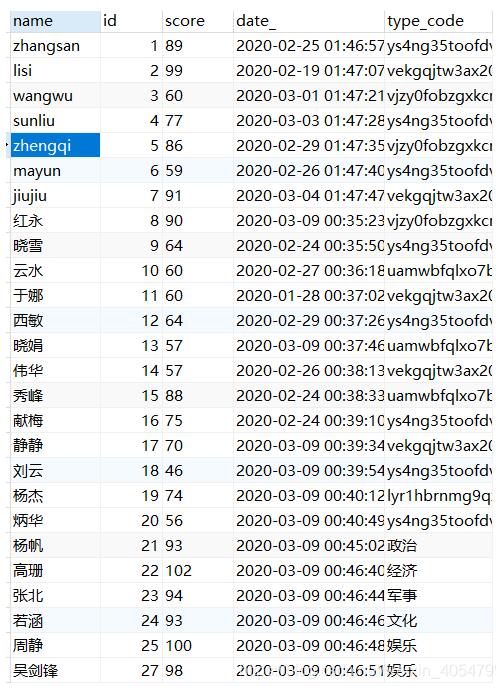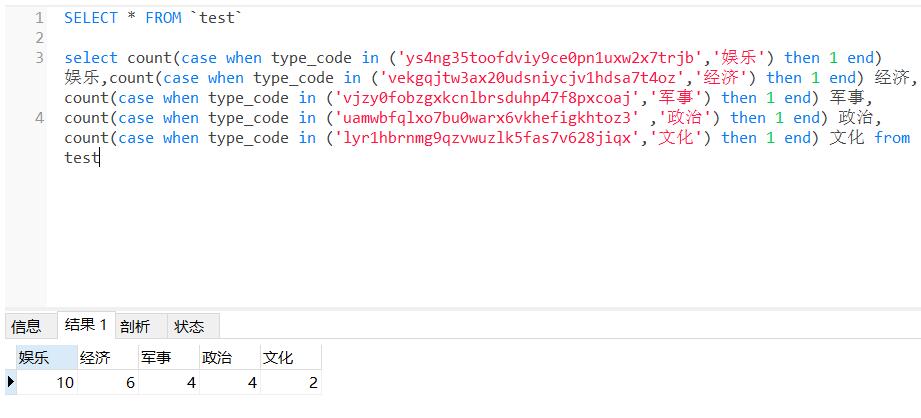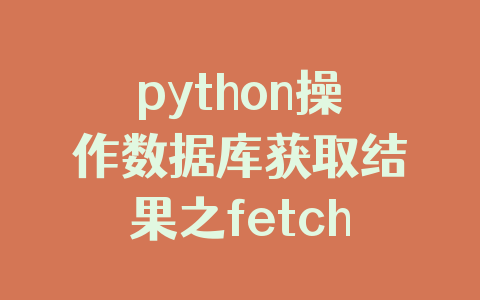数据库中有一字段type_code,有中文类型和中文类型编码,现在对type_code字段的数据进行统计处理,编码对应的字典如下:
{\'ys4ng35toofdviy9ce0pn1uxw2x7trjb\':\'娱乐\',
\'vekgqjtw3ax20udsniycjv1hdsa7t4oz\':\'经济\',
\'vjzy0fobzgxkcnlbrsduhp47f8pxcoaj\':\'军事\',
\'uamwbfqlxo7bu0warx6vkhefigkhtoz3\':\'政治\',
\'lyr1hbrnmg9qzvwuzlk5fas7v628jiqx\':\'文化\',
}
其中数据库的32位随机编码生成程序如下:
string.ascii_letters 对应字母(包括大小写), string.digits(对应数字) ,string.punctuation(对应特殊字符)
import string
import random
def get_code():
return \'\'.join(random.sample(string.ascii_letters + string.digits + string.punctuation, 32))
print(get_code())
def get_code1():
return \'\'.join(random.sample(string.ascii_letters + string.digits, 32))
testresult= get_code1()
print(testresult.lower())
print(type(testresult))
结果:
)@+t37/b|UQ[K;!spj<(>%r9\"PokwTe= igwle98kgqtcprke7byvq12xnhucmz4v <class \'str\'>
cur.fetchall:
import pymysql import pandas as pd conn = pymysql.Connect(host=\"127.0.0.1\",port=3306,user=\"root\",password=\"123456\",charset=\"utf8\",db=\"sql_prac\") cur = conn.cursor()
print(\"连接成功\") sql = \"SELECT type_code,count(1) as num FROM test GROUP BY type_code ORDER BY num desc\" cur.execute(sql) res = cur.fetchall() print(res)
((\'ys4ng35toofdviy9ce0pn1uxw2x7trjb\', 8), (\'vekgqjtw3ax20udsniycjv1hdsa7t4oz\', 5), (\'vjzy0fobzgxkcnlbrsduhp47f8pxcoaj\', 3), (\'uamwbfqlxo7bu0warx6vkhefigkhtoz3\', 3), (\'娱乐\', 2), (\'lyr1hbrnmg9qzvwuzlk5fas7v628jiqx\', 1), (\'政治\', 1), (\'经济\', 1), (\'军事\', 1), (\'文化\', 1)) res = pd.DataFrame(list(res), columns=[\'name\',\'value\']) print(res)
dicts = {\'ys4ng35toofdviy9ce0pn1uxw2x7trjb\':\'娱乐\',
\'vekgqjtw3ax20udsniycjv1hdsa7t4oz\':\'经济\',
\'vjzy0fobzgxkcnlbrsduhp47f8pxcoaj\':\'军事\',
\'uamwbfqlxo7bu0warx6vkhefigkhtoz3\':\'政治\',
\'lyr1hbrnmg9qzvwuzlk5fas7v628jiqx\':\'文化\',
}
res[\'name\'] = res[\'name\'].map(lambda x:dicts[x] if x in dicts else x)
print(res)
name value 0 娱乐 8 1 经济 5 2 军事 3 3 政治 3 4 娱乐 2 5 文化 1 6 政治 1 7 经济 1 8 军事 1 9 文化 1
#分组统计 result = res.groupby([\'name\']).sum().reset_index() print(result) name value 0 军事 4 1 娱乐 10 2 政治 4 3 文化 2 4 经济 6
#排序 result = result.sort_values([\'value\'], ascending=False) name value 1 娱乐 10 4 经济 6 0 军事 4 2 政治 4 3 文化 2
#输出为list,前端需要的数据格式
data_dict = result.to_dict(orient=\'records\')
print(data_dict)
[{\'name\': \'娱乐\', \'value\': 10}, {\'name\': \'经济\', \'value\': 6}, {\'name\': \'军事\', \'value\': 4}, {\'name\': \'政治\', \'value\': 4}, {\'name\': \'文化\', \'value\': 2}]
cur.fetchone
先测试SQL:
代码:
import pymysql
import pandas as pd
conn = pymysql.Connect(host=\"127.0.0.1\",port=3306,user=\"root\",password=\"123456\",charset=\"utf8\",db=\"sql_prac\")
cur = conn.cursor()
print(\"连接成功\")
sql = \"select count(case when type_code in (\'ys4ng35toofdviy9ce0pn1uxw2x7trjb\',\'娱乐\') then 1 end) 娱乐,\" \\
\"count(case when type_code in (\'vekgqjtw3ax20udsniycjv1hdsa7t4oz\',\'经济\') then 1 end) 经济,\" \\
\"count(case when type_code in (\'vjzy0fobzgxkcnlbrsduhp47f8pxcoaj\',\'军事\') then 1 end) 军事,\" \\
\"count(case when type_code in (\'uamwbfqlxo7bu0warx6vkhefigkhtoz3\' ,\'政治\') then 1 end) 政治,\" \\
\"count(case when type_code in (\'lyr1hbrnmg9qzvwuzlk5fas7v628jiqx\',\'文化\') then 1 end) 文化 from test\"
cur.execute(sql)
res = cur.fetchone()
print(res)
返回结果为元组:
(10, 6, 4, 4, 2)
data = [
{\"name\": \"娱乐\", \"value\": res[0]},
{\"name\": \"经济\", \"value\": res[1]},
{\"name\": \"军事\", \"value\": res[2]},
{\"name\": \"政治\", \"value\": res[3]},
{\"name\": \"文化\", \"value\": res[4]}
]
result = sorted(data, key=lambda x: x[\'value\'], reverse=True)
print(result)
结果和 cur.fetchall返回的结果经过处理后,结果是一样的:
[{\'name\': \'娱乐\', \'value\': 10}, {\'name\': \'经济\', \'value\': 6}, {\'name\': \'军事\', \'value\': 4}, {\'name\': \'政治\', \'value\': 4}, {\'name\': \'文化\', \'value\': 2}]
补充:今天做测试,用django.db 的connection来执行一个非常简单的查询语句:
sql_str = \'select col_1 from table_1 where criteria = 1\' cursor = connection.cursor() cursor.execute(sql_str) fetchall = cursor.fetchall()
fetchall的值是这样的:
((\'101\',), (\'102\',), (\'103\',),(\'104\',))
上网搜索了一下资料:
首先fetchone()函数它的返回值是单个的元组,也就是一行记录,如果没有结果,那就会返回null
其次是fetchall()函数,它的返回值是多个元组,即返回多个行记录,如果没有结果,返回的是()
举个例子:cursor是我们连接数据库的实例
fetchone()的使用:
cursor.execute(select username,password,nickname from user where id=\'%s\' %(input)
result=cursor.fetchone(); 此时我们可以通过result[0],result[1],result[2]得到username,password,nickname
fetchall()的使用:
cursor.execute(select * from user)
result=cursor.fetchall();此时select得到的可能是多行记录,那么我们通过fetchall得到的就是多行记录,是一个二维元组
((username1,password1,nickname1),(username2,password2,nickname2),(username3,password3,nickname))
以上为个人经验,希望能给大家一个参考,也希望大家多多支持自学编程网。如有错误或未考虑完全的地方,望不吝赐教。
















